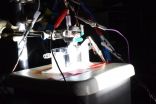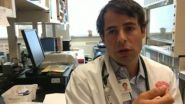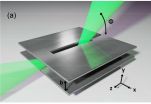(Press-News.org) (BOSTON) - Stem cell therapies are often limited by low survival of transplanted stem cells and the lack of precise control over their differentiation into the terminal cell types needed to repair or replace injured tissues. Now, a team led by Wyss Institute Core Faculty member David Mooney, Ph.D., has developed a new strategy - embedding stem cells into porous, transplantable hydrogels - that has experimentally improved bone repair by boosting the survival rate of transplanted stem cells and influencing their cell differentiation.
Mooney - who is also the Robert P. Pinkas Family Professor of Bioengineering at the Harvard John A. Paulson School of Engineering and Applied Sciences (SEAS) - and his team published their findings in the September 14 issue of Nature Materials. The team included Georg Duda, Ph.D., who a Wyss Associate Faculty member and the director of the Julius Wolff Institute and Professor of Biomechanics and Musculoskeletal Regeneration at Charité - Universitätsmedizin Berlin, and Wyss Institute Founding Director Donald Ingber, M.D., Ph. D., who is also the Judah Folkman Professor of Vascular Biology at Harvard Medical School and Boston Children's Hospital and Professor of Bioengineering at SEAS.
Stem cell therapies bear tremendous hopes for the repair of many tissues and bone or even the replacement of entire organs. Tissue-specific stem cells can now be generated in the laboratory. However, no matter how well they grow in the laboratory, stem cells must survive after they are transplanted and function correctly at the site of injury to be useful for clinical regenerative therapies. As of now, transplanted cell death remains a major challenge.
To improve the therapeutic ability of transplanted stem cells, Mooney's team has drawn inspiration from naturally occurring stem cell "niches. " A 'stem cell niche' is a unique support system for stem cells consisting of other cell types and an extracellular molecular matrix that affects their fate.
Recently, Mooney's team as well as other researchers have identified specific chemical and physical cues from the niche that act in concert to promote stem cell survival, multiplication and maturation into tissue. Whereas chemical signals that control stem cell behavior are increasingly understood, much less is known about the mechanical properties of stem cell niches. Stem cells like those present in bone, cartilage or muscle cultured in laboratories, however, have been found to possess mechanosensitivities; meaning they require a physical substrate with defined elasticity and stiffness to proliferate and mature on.
"So far these physical influences had not been efficiently harnessed to propel real world regeneration processes," said Nathaniel Huebsch, a Graduate Student who worked with Mooney and who is the study's first author. "Based on our experience with mechanosensitive stem cells, we hypothesized that hydrogels could be leveraged to generate the right chemical and mechanical cues in a first model of bone regeneration."
Key to the method developed by Mooney's team is the combination of two water-filled hydrogels with very different properties. A more stable, longer lasting 'bulk gel' is filled with small bubbles of a second, so-called 'porogen' that degrades at a much faster rate, leaving behind porous cavities.
By coupling the bulk gel with a small peptide derived from the extracellular environment of genuine stem cell niches, and mixing it with a tissue-specific stem cell type as well as the porogen, the team can create a bone-forming artificial niche. While the bulk gel provides just the right amount of elasticity plus a relevant chemical signal to coax stem cells into proliferation and send them on their maturation path, the porogen gradually breaks down, leaving open spaces for the stem cells to expand into before they naturally migrate out of the gel structure altogether to form actual mineralized bone tissue.
In small animal experiments conducted so far, the researchers show that a void-forming hydrogel with the correct chemical and elastic properties provides better bone regeneration than transplanting stem cells alone. Of further interest, the maturing stem cells deployed by the hydrogel also induce nearby native stem cells to contribute to bone repair, thus further amplifying their regenerative effects.
"This study provides the first demonstration that the physical properties of a biomaterial can not only help deliver stem cells but also tune their behavior in vivo," said Mooney. "While so far we have focused on orchestrating bone formation, we believe that our hydrogel concept can be broadly applied to other regenerative processes as well."
The collaborative, cross-disciplinary work was supported by the Harvard University Materials Research Science and Engineering Center (MRSEC), which is funded by the National Science Foundation (NSF).
"This is an exquisite demonstration of MRSEC programs' high impact," said Dan Finotello, program director at the NSF. "MRSECs bring together several researchers of varied experience and complementary expertise who are then able to advance science at a considerably faster rate."
INFORMATION:
Additional funding was provided by: the National Institutes of Health; the Belgian American Education Foundation; the Einstein Foundation Berlin; the Berlin-Brandenburg School for Regenerative Therapies; the Harvard College Research Program; and NSF Graduate Research, Einstein Visiting, Harvard College PRISE, Herchel-Smith and Pechet Family Fund Fellowships.
(Boston)--A panel of experts and researchers have developed a new classification system for gout, the most common form of inflammatory arthritis. This new system standardizes the classification of this condition using a variety of evidence-based criteria.
Led by a researchers at Boston University School of Medicine (BUSM) and institutions from around the world, the study is a joint publication appearing in two journals simultaneously, Annals of Rheumatologic Disease and Arthritis & Rheumatology.
Gout is characterized by the deposition of a specific type of crystal in ...
GAINESVILLE, Fla. -- Larger and private colleges and universities seem to attract hookah cafes and lounges, but smoke-free policies decrease these odds, according to findings published in the American Journal of Preventive Medicine this month.
That may bode well for the long-term health of college-age students.
Waterpipe smoking, more commonly known as hookah, boasts enticing flavors and a healthier reputation, increasing its popularity among college students. It is estimated that more than 10 percent of U.S. college students are current users.
However, recent evidence ...
MADISON, Wis. -- Hydrogen could be the ideal fuel: Whether used to make electricity in a fuel cell or burned to make heat, the only byproduct is water; there is no climate-altering carbon dioxide.
Like gasoline, hydrogen could also be used to store energy.
Hydrogen is usually produced by separating water with electrical power. And although the water supply is essentially limitless, a major roadblock to a future "hydrogen economy" is the need for platinum or other expensive noble metals in the water-splitting devices.
Noble metals resist oxidation and include many ...
Societies are failing women, children and adolescents, particularly in the poorest communities around the world, and urgent action is needed to save lives and improve health, say global health experts.
In a special supplement published today by The BMJ, public health experts from around the globe highlight the critical actions and investments that will have the greatest impact on the health and well-being of women, children and adolescents.
The 15 papers in this special supplement outline the current evidence, identify successes as well as critical gaps in progress, ...
Montreal, September 14, 2015 - Using extensive genetic data compiled by the UK10K project, an international team of researchers led by Dr. Brent Richards of the Lady Davis Institute at the Jewish General Hospital has identified a genetic variant near the gene EN1 as having the strongest effect on bone mineral density (BMD) and fracture identified to date. The findings are published in the forthcoming issue of the prestigious journal Nature.
"EN1 has never before been linked to osteoporosis in humans, so this opens up a brand new pathway to pursue in developing drugs to ...
BLOOMINGTON, Ind. -- A study three years ago sparked a medical mystery when it revealed a part of the brain not found in any present-day anatomy textbooks.
Recently, Indiana University computational neuroscientist Franco Pestilli and an international research team published an article in the journal Cerebral Cortex that suggests this missing part of the brain may play an important role in how we understand the world -- despite getting "lost" for more than a century.
A long flat bundle of nerves called the vertical occipital fasciculus, or VOF, the structure appeared ...
Researchers at Cardiff University have devised a way of increasing the yield of biodiesel by using the waste left over from its production process.
Using simple catalysis, the researchers have been able to recycle a non-desired by-product produced when biodiesel is formed from vegetable oil, and convert this into an ingredient to produce even more biodiesel.
It is believed this new process will have significant environmental benefits by improving the yield of biodiesel in a sustainable way that doesn't require the use of additional fossil fuels, and could potentially ...
PROVIDENCE, R.I. [Brown University] -- Terahertz radiation could one day provide the backbone for wireless systems that can deliver data up to one hundred times faster than today's cellular or Wi-Fi networks. But there remain many technical challenges to be solved before terahertz wireless is ready for prime time.
Researchers from Brown University have taken a major step toward addressing one of those challenges. They've developed what they believe to be the first system for multiplexing terahertz waves. Multiplexers are devices that enable separate streams of data to ...
(SACRAMENTO, Calif.) -- Vitamin D insufficiency among the elderly is highly correlated with accelerated cognitive decline and impaired performance, particularly in domains such as memory loss that are associated with Alzheimer's disease and dementia, researchers with the UC Davis Alzheimer's Disease Center and Rutgers University have found. The effect is "substantial," with individuals with low vitamin D declining at a rate three times faster than those with adequate vitamin D levels.
The researchers said their findings amplify the importance of identifying vitamin D ...
Vitamin D insufficiency was associated with faster decline in cognitive functions among a group of ethnically diverse older adults, according to an article published online by JAMA Neurology.
In addition to promoting calcium absorption and bone health, vitamin D may influence all organ systems. Both the vitamin D receptor and the enzyme that converts 25-hydroxyvitamin D (25-OHD) to the active form of the vitamin are expressed in all human organs, including the brain. Thus, research has increasingly examined the association between vitamin D status and a variety of health ...



